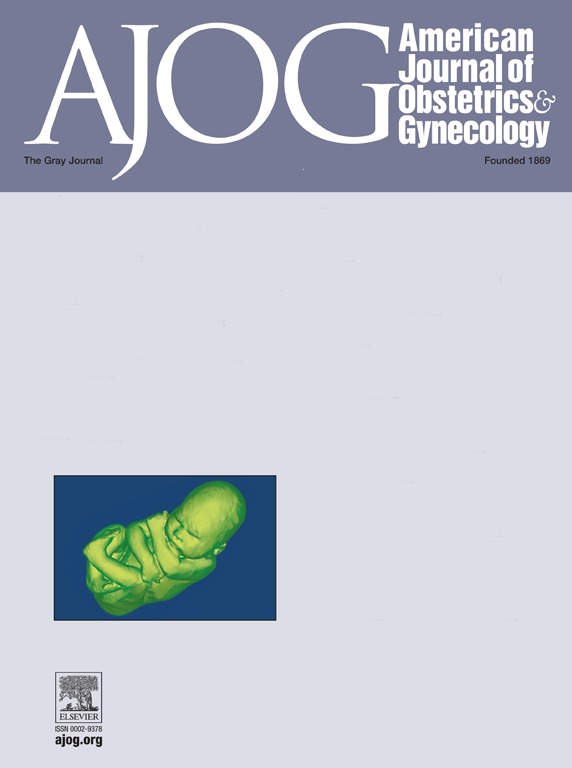Cerebral infarcts, edema, hypoperfusion, and vasospasm in preeclampsia and eclampsia
IF 8.7
1区 医学
Q1 OBSTETRICS & GYNECOLOGY
引用次数: 0
Abstract
Background
Eclampsia is a serious pregnancy complication and is associated with cerebral edema and infarctions. However, the underlying pathophysiology of eclampsia remains poorly explored.
Objective
This study aimed to assess the pathophysiology of eclampsia using specialized magnetic resonance imaging to measure diffusion, perfusion, and vasospasm.
Study Design
This was a cross-sectional study recruiting consecutive pregnant women between April 2018 and November 2021 at Tygerberg Hospital, Cape Town, South Africa. Women with eclampsia, preeclampsia, and normotensive pregnancies who underwent magnetic resonance imaging after birth were recruited. The main outcome measures were cerebral infarcts, edema, and perfusion using intravoxel incoherent motion imaging and vasospasm using magnetic resonance imaging angiography. The imaging protocol was established before inclusion.
Results
Here, 49 women with eclampsia, 20 women with preeclampsia, and 10 normotensive women were included. Cerebral infarcts were identified in 34% of women with eclampsia and 5% of women with preeclampsia (risk difference, 0.29; 95% confidence interval, 0.06–0.52; P=.012). However, no cerebral infarct was identified in normotensive controls. Women with eclampsia were more likely to have vasogenic cerebral edema than women with preeclampsia (80% vs 20%, respectively; risk difference, 0.60; 95% confidence interval, 0.34–0.85; P<.001) and normotensive women (risk difference, 0.80; 95% confidence interval, 0.47–1.00; P<.001). Diffusion was increased in women with eclampsia in the parieto-occipital white matter (mean difference, 0.02 × 10−3 mm2/s; 95% confidence interval, 0.00–0.05; P=.045) and caudate nucleus (mean difference, 0.02 × 10−3 mm2/s; 95% confidence interval, 0.00–0.04; P=.033) compared with women with preeclampsia. In addition, diffusion was increased in women with eclampsia in the frontal white matter (mean difference, 0.07 × 10−3 mm2/s; 95% confidence interval, 0.02–0.12; P=.012), parieto-occipital white matter (mean difference, 0.05 × 10−3 mm2/s; 95% confidence interval, 0.02–0.07; P=.03), and caudate nucleus (mean difference, 0.04 × 10−3 mm2/s; 95% confidence interval, 0.00–0.07; P=.028) compared with normotensive women. Perfusion was decreased in edematous regions. Hypoperfusion was present in the caudate nucleus in eclampsia (mean difference, −0.17 × 10−3 mm2/s; 95% confidence interval, −0.27 to −0.06; P=.003) compared with preeclampsia. There was no sign of hyperperfusion. Vasospasm was present in 18% of women with eclampsia and 6% of women with preeclampsia. However, no vasospasm was present in the controls.
Conclusion
Eclampsia was associated with cerebral infarcts, vasogenic cerebral edema, vasospasm, and decreased perfusion, which are not usually evident on standard clinical imaging. This finding may explain why some patients have cerebral symptoms and signs despite having normal conventional imaging.
先兆子痫和子痫的脑梗塞、水肿、低灌注和血管痉挛。
背景:子痫是一种严重的妊娠并发症:子痫是一种严重的妊娠并发症,与脑水肿和脑梗塞有关,但其潜在的病理生理学在很大程度上仍未得到探讨:研究设计:这是一项横断面研究,招募了2018年4月至2021年11月期间在南非开普敦泰格贝格医院连续就诊的孕妇。我们招募了子痫、子痫前期和血压正常的孕妇,她们在出生后接受了磁共振成像检查。主要结果测量指标为体外非相干运动成像中的脑梗塞、水肿和灌注,以及磁共振成像血管造影中的血管痉挛。成像方案在纳入前已确定:结果:纳入了 49 名子痫妇女、20 名先兆子痫妇女和 10 名血压正常妇女。34%的子痫患者、5%的子痫前期患者(风险差异(RD)为0.29;95%置信区间(CI)为0.06至0.52,P=0.012)和无正常血压对照组患者中发现了脑梗塞。与子痫前期妇女相比,子痫妇女更容易出现血管源性脑水肿(80% vs 20%,RD 0.60;CI 0.34 至 0.85,p-3 mm2/s,CI 0.00 至 0.05,p=0.045),与子痫前期妇女相比,尾状核更容易出现血管源性脑水肿(MD 0.02 x10-3 mm2/s,CI 0.00 至 0.04,p=0.033)。与血压正常的妇女相比,癫痫妇女额叶(MD 0.07 x10-3 mm2/s,CI 0.02 至 0.12,p=0.012)和顶枕叶白质(MD 0.05 x10-3 mm2/s,CI 0.02 至 0.07,p=0.03)以及尾状核(MD 0.04 x10-3 mm2/s,CI 0.00 至 0.07,p=0.028)的弥散也有所增加。水肿区域的灌注量减少。与子痫前期相比,子痫患者尾状核灌注不足(MD -0.17 x10-3 mm2/s,CI -0.27至-0.06,P=0.003)。没有过度灌注的迹象。18%的子痫患者、6%的子痫前期患者和无对照组患者出现血管痉挛:子痫与脑梗塞、血管源性脑水肿、血管痉挛和灌注减少有关,这些症状在标准临床影像学检查中通常并不明显。这可能解释了为什么有些患者尽管常规影像学检查正常,但仍有脑部症状和体征。
本文章由计算机程序翻译,如有差异,请以英文原文为准。
求助全文
约1分钟内获得全文
求助全文
来源期刊
CiteScore
15.90
自引率
7.10%
发文量
2237
审稿时长
47 days
期刊介绍:
The American Journal of Obstetrics and Gynecology, known as "The Gray Journal," covers the entire spectrum of Obstetrics and Gynecology. It aims to publish original research (clinical and translational), reviews, opinions, video clips, podcasts, and interviews that contribute to understanding health and disease and have the potential to impact the practice of women's healthcare.
Focus Areas:
Diagnosis, Treatment, Prediction, and Prevention: The journal focuses on research related to the diagnosis, treatment, prediction, and prevention of obstetrical and gynecological disorders.
Biology of Reproduction: AJOG publishes work on the biology of reproduction, including studies on reproductive physiology and mechanisms of obstetrical and gynecological diseases.
Content Types:
Original Research: Clinical and translational research articles.
Reviews: Comprehensive reviews providing insights into various aspects of obstetrics and gynecology.
Opinions: Perspectives and opinions on important topics in the field.
Multimedia Content: Video clips, podcasts, and interviews.
Peer Review Process:
All submissions undergo a rigorous peer review process to ensure quality and relevance to the field of obstetrics and gynecology.

 求助内容:
求助内容: 应助结果提醒方式:
应助结果提醒方式:


